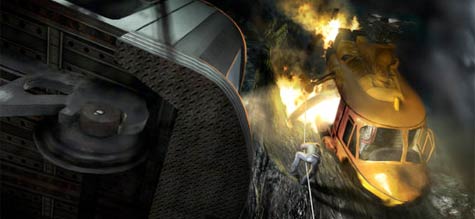There’s been some really interesting posts on the games blogs recently about the relationship between the player, their character, and the game’s camera. Obvious highlights include Mitch Krpata’s recent post about cameras, and his follow-up, about the camera’s implementation in EA’s Dead Space. In his first post, Krpata outlines the issues:
In a game, there are three entities sharing control of the experience: the player, the camera, and the character. The difference [between games and eg. books] is that these don’t exist on a straight line. They all overlap, like a Venn diagram. In a first-person shooter like Half-Life, the player, the camera, and the character are all the same. In a third-person action-adventure game like God of War, the camera and the player are distinct, but the player and the character are mostly one and the same. In a strategy game like Warcraft, the player and the camera are the same, but the characters are on their own.
Krpata in turn was responding to Corvus Elrod’s excellent series of posts about the camera in gaming. In one, Corvus comments:
…it’s only a matter of time before someone turns their artistic attention to the video game camera and implements a system so risky, so rewarding, so compelling, that it changes the vocabulary of game cameras forever.
Vocabulary is an interesting word; an important part of the process of understanding an issue is finding a way to express it, and I think a lot of the vocabulary of games-cameras is currently derived from cinema. We need to move towards a game-native vocabulary for cameras, and whilst something might change that vocabulary forever, I think it might be a slower, more evolutionary process.
And that all leads me to the post I wanted to write about originally, which is about a single thing the camera does in Alone In The Dark.

I recently downloaded the demo of Alone in the Dark (hereafter AITD) from Xbox Live, mainly because I was curious about the game: its review scores were all over the place, and the best I could ascertain from the forums was that it was very much a thing of shreds and patches.
The demo confirms that. It veers from moments of brilliance (in terms of graphics engine and interaction design) to appalling control implementations and awkward combat. The in-coat inventory is a classic example – it’s a beautiful interface, and really appropriate, totally ruined by the way you manipulate it. It’s hard to call a game that takes so many risks bad, but it falls on its face in many areas. I’m really not sure I could face playing the whole thing.
But. There’s always a but. And in this case, it was something the game does with the camera that is so daring, so brilliant, I couldn’t help but be impressed.
The game begins in a first-person perspective. Your character is somewhat groggy, having been kidnapped, and his vision has a habit of blurring. The only way to clear it is to blink, an action performed by clicking the right thumbstick. In the first five minutes, you do a lot of blinking.
This is cute, but it isn’t the thing that impressed me.
After the initial sequence, you eventually come across a mirror, and the game jumps to a cut-scene, viewed from the third person, where your character sees himself in the mirror. The camera pans around him, taking him in, as he admits that he has no idea who he is. He doesn’t recognise the man in the mirror.
Then, you realise the cutscene is over, and the game has jumped to a third person perspective.
That’s what I thought was brilliant: the idea of tying the camera into the narrative like that. You’re only allowed to see your character when the character has finally seen himself; the perspective shift represents the amnesiac Carnby seeing himself for the first time. From this point on, you can toggle between first and third person (and you tend to do it a bit – certain actions are easier from each perspective), and the action loses its significance. But the first time it happens, it’s a real surprise, and it’s really smart: the game’s interface reflects the character’s understanding of himself.
That feels like a game-native understanding of camera: the idea that camera can be something that helps to express the seams between the player and the character. Which is, of course, what the camera in games is: a kind of boundary object between the player and the character.

